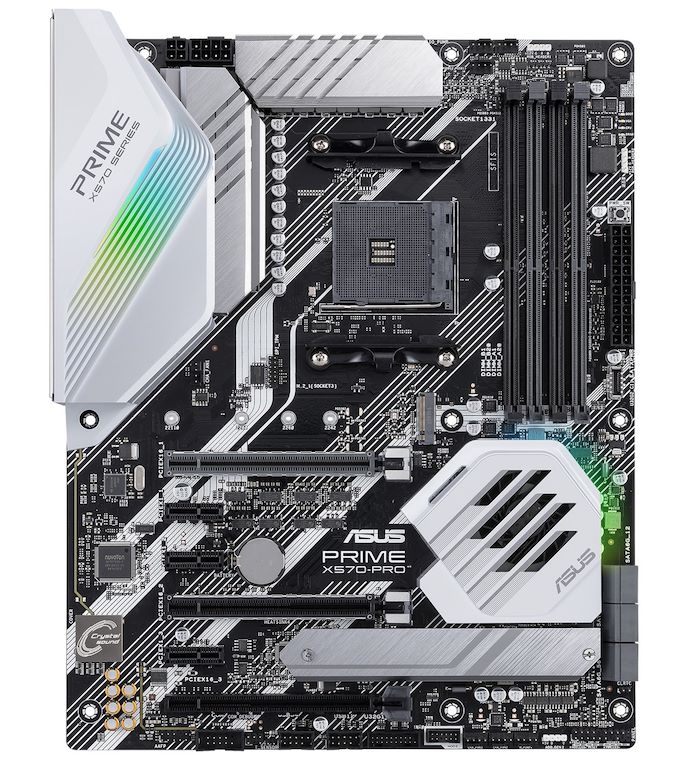The AMD X570 Motherboard Overview: Over 35+ Motherboards Analyzed
by Gavin Bonshor on July 9, 2019 8:00 AM ESTASUS Prime X570-Pro
Moving onto the ASUS Prime series of X570 motherboards, the ASUS Prime X570-Pro represents the more feature-laden of two ATX sized models; the other being the ASUS Prime X570-P. The ASUS Prime X570-Pro represents its less aggressive and non-gaming Prime range with a more subtle white and black aesthetic. The most notable aspects of the feature set include a Realtek S1220A HD audio codec, Gigabit NIC, and support for up to 128 GB of DDR4 memory.
The ASUS Prime X570-Pro offers three full-length PCIe 4.0 slots which run at x16, x8/x8, and x8/x8/x4. This allows for users to use two-way NVIDIA SLI and up to three-way AMD Crossfire multi-graphics card setups. Also present is three PCIe 4.0 x1 slots, with the board's storage capabilities coming through two PCIe 4.0 x4 M.2 slots, with the bottom slot coming with a heatsink; there are also six SATA ports with support for RAID 0, 1 and 10 arrays. In the top right-hand corner is four memory slots with support for up to 128 GB which allows users to install the 32 GB UDIMMs that has started making its way onto the market.
On the rear panel, the ASUS Prime X570-Pro includes three USB 3.1 G2 Type-A, one USB 3.1 G2 Type-C, and four USB 3.1 G1 Type-A ports. Adopters of AMD's impending Ryzen 3000 APUs and the Ryzen 2400/2200G will appreciate the HDMI and DisplayPort video outputs. There is also a PS/2 keyboard and mouse combo port, an Intel I211-AT Gigabit powered Ethernet port, and five 3.5 mm audio jacks and S/PDIF optical output driven by a Realtek S1220A HD audio codec.
The ASUS Prime X570-Pro has an MSRP of $250 and is more suited to users looking to avoid the swathe of gaming-themed models on the market. What the Prime series offers is elegant and neutral designs, which would actually look quite good with some RGB to make the white rear panel cover pop. There's support for two-way NVIDIA SLI and three-way AMD CrossFire too so users looking to build a more subtly styled gaming system can do so.












225 Comments
View All Comments
DigitalFreak - Tuesday, July 9, 2019 - link
Agreed. The major differences between pricing in motherboards nowadays is how well they support overclocking, how many / what type of Ethernet ports, and how much RGB garbage they throw on there. :-)brunis.dk - Wednesday, July 10, 2019 - link
Retarded Garbage Blinking!29a - Wednesday, July 10, 2019 - link
RGB changes the price by pennies at the most.jrs77 - Tuesday, July 9, 2019 - link
If it wasn't for the optical digital output I'd agree, but these seem to be rather rare and not common at all. A couple years back that wasn't the case, so I see an actual backwards trend here that comes with a lack of necessary ports. Atleast an optical digital output is necessary for me.lmcd - Friday, July 26, 2019 - link
I mean sure, but a decent number of them were completely useless from a terrible onboard chipset. Pretty sure one of my two desktops had one that maxed out at 2.0 channel over optical digital output.Silma - Thursday, July 11, 2019 - link
This would have been true, but for the dearth of ThunderBolt 3 ports, needed for audio interfaces for example.lso the price of most of the boards is outrageous compared to their real added value, imho.
umano - Friday, July 12, 2019 - link
I agree with Silma, for example the great asrock x299 itx at launch had a price tag of 399, with 4 memory channel and sodimm slot and 3 nvme. Something's wrong, or the amd statement is false (most modern i/o), or the mb manufacturers did not get the best from x570regsEx - Friday, July 19, 2019 - link
I like it either. But back in days, top Intel's Asrock P67 Fatali1y Professional was priced at $120. For that price you were getting 16+2 phase power, cooling with a pipe 3 brand new Etron USB 3.0 controllers (USB 3.2 Gen 1), additional PCIe controller, best at the time Realtek ALC892 sound, 2 Realtek RTL8111 LAN controllers, additional Marvell SATA controller, Dr. Debug display, power and reset buttons, 3.5" front USB 3 panel, additional rear USB 3 bracket and SLI bridge in the box. That was first generation of motherboards of XMP profiles and new graphical AMI UEFI (return of graphical AMI BIOS after 15 years) etc etc. Just $120. Now to get similar set you have to pay at least $360. And for $120 you can only get some poor office board. And ASRock was cheapest of high end boards back then. Now it's most expensive.regsEx - Friday, July 19, 2019 - link
"best at the time Realtek ALC892 sound"I mean best of Realtek. Obviously there were Creative X-Fi.
Marlin1975 - Tuesday, July 9, 2019 - link
How soon before you can test the x570 boards? Really curious how pcie 3 m.2 cards perform in them with 2000 and 3000 series cpus. Does the new chipset help performance for 2000 cpus or even 3000 cpus compared to x470 and b450 boards?And any word on future mATX boards? Only 1 so far seems weird and also a monoply for asrock.